Reward System, Performance Management, and Sustainability
VerifiedAdded on 2019/12/18
|16
|5012
|223
Essay
AI Summary
The provided assignment content consists of a collection of academic articles published between 2013 to 2015. The topics covered include energy and performance management, neuroscience and psychology, and organizational behavior. Specifically, the articles discuss various aspects such as profit maximization approaches in green data centers, the role of oxytocin in brain reward system responses, and the relationship between attentional biasing and economic decision-making performance. Additionally, there are articles on deep brain stimulation for major depression, sustainability management beyond corporate boundaries, and reward system dysfunction in patients with schizophrenia. The assignment also includes illustrations of expectancy theory and the balance score card, which may be relevant to organizational behavior or management topics.
Contribute Materials
Your contribution can guide someone’s learning journey. Share your
documents today.
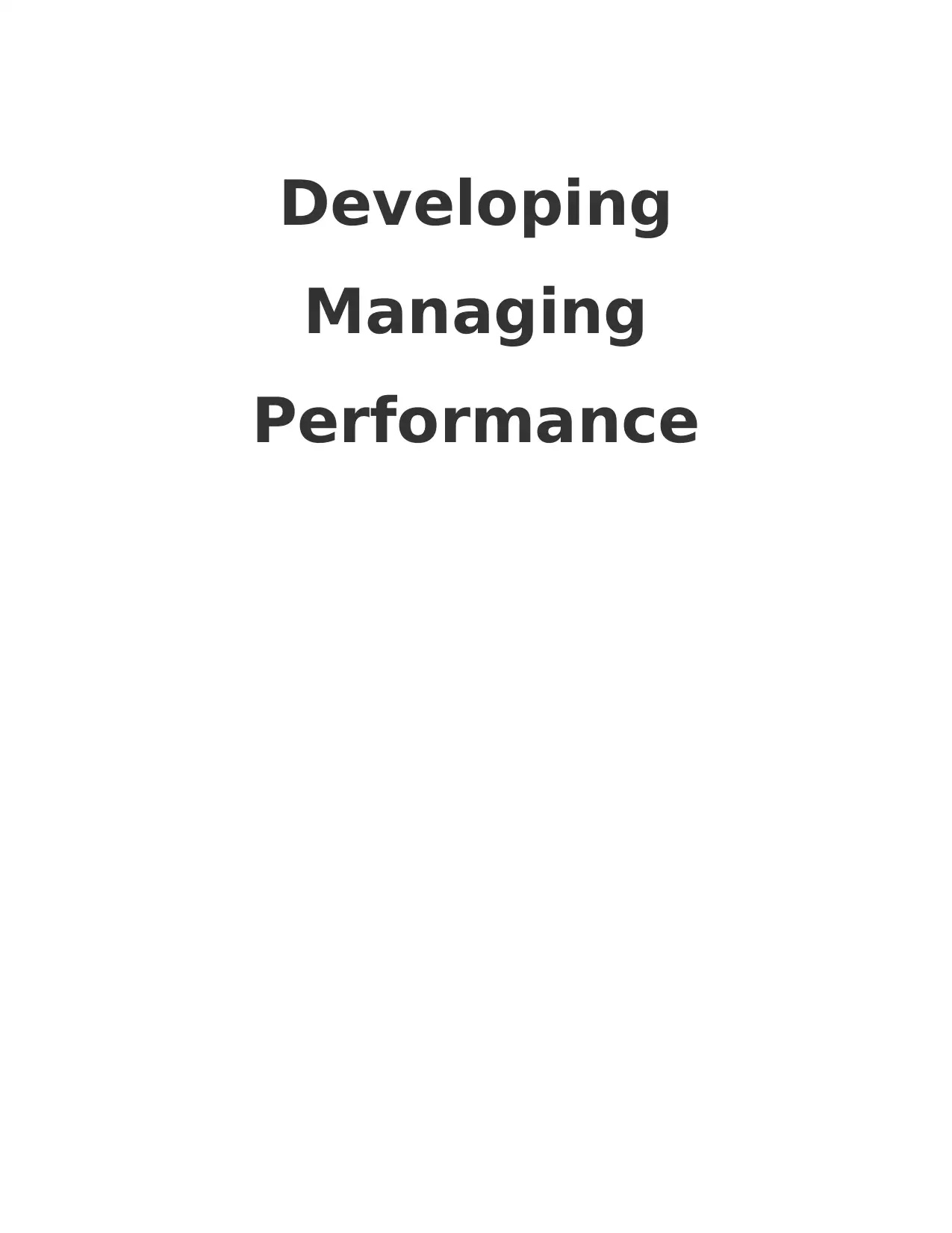
Developing
Managing
Performance
Managing
Performance
Secure Best Marks with AI Grader
Need help grading? Try our AI Grader for instant feedback on your assignments.
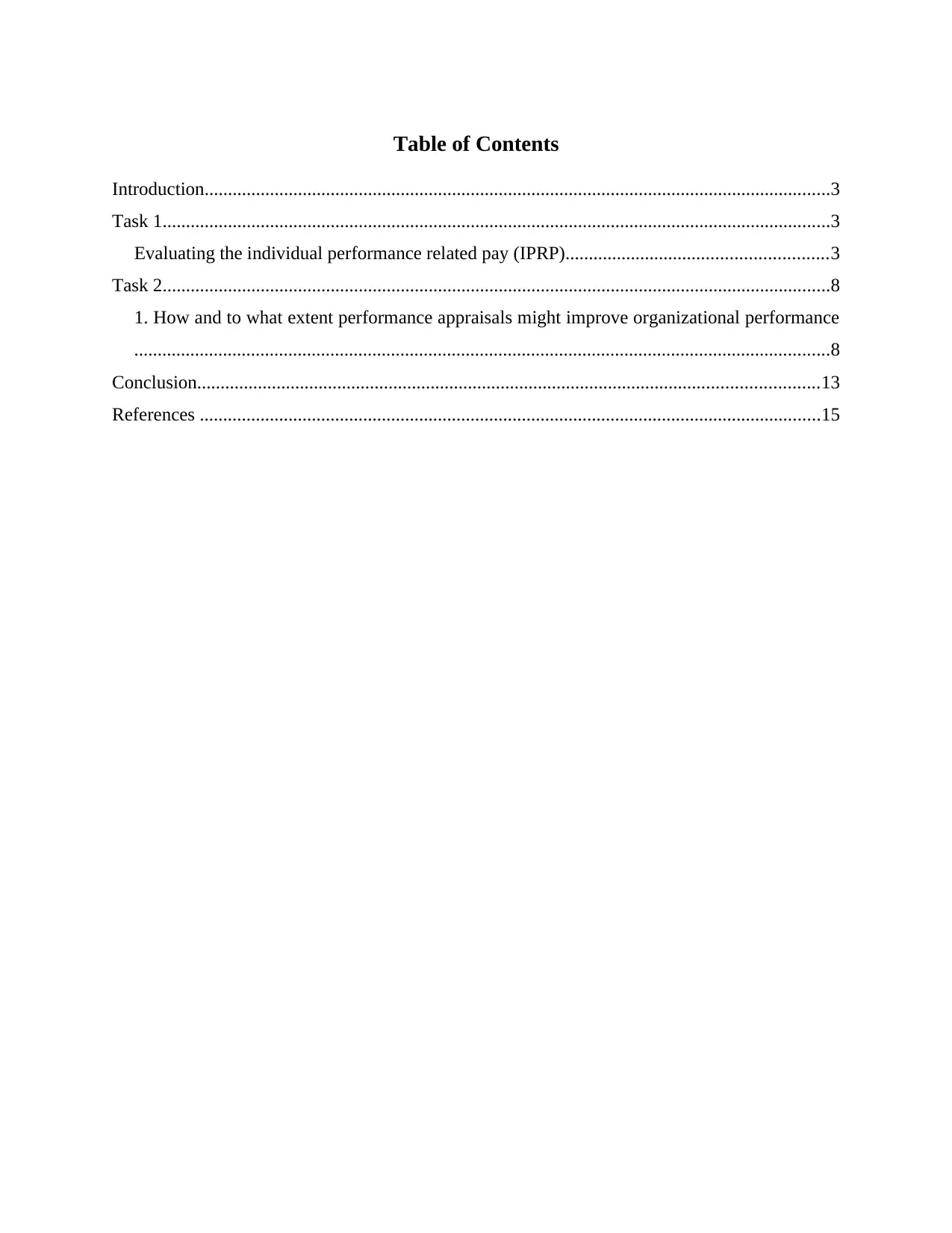
Table of Contents
Introduction......................................................................................................................................3
Task 1...............................................................................................................................................3
Evaluating the individual performance related pay (IPRP)........................................................3
Task 2...............................................................................................................................................8
1. How and to what extent performance appraisals might improve organizational performance
.....................................................................................................................................................8
Conclusion.....................................................................................................................................13
References .....................................................................................................................................15
Introduction......................................................................................................................................3
Task 1...............................................................................................................................................3
Evaluating the individual performance related pay (IPRP)........................................................3
Task 2...............................................................................................................................................8
1. How and to what extent performance appraisals might improve organizational performance
.....................................................................................................................................................8
Conclusion.....................................................................................................................................13
References .....................................................................................................................................15
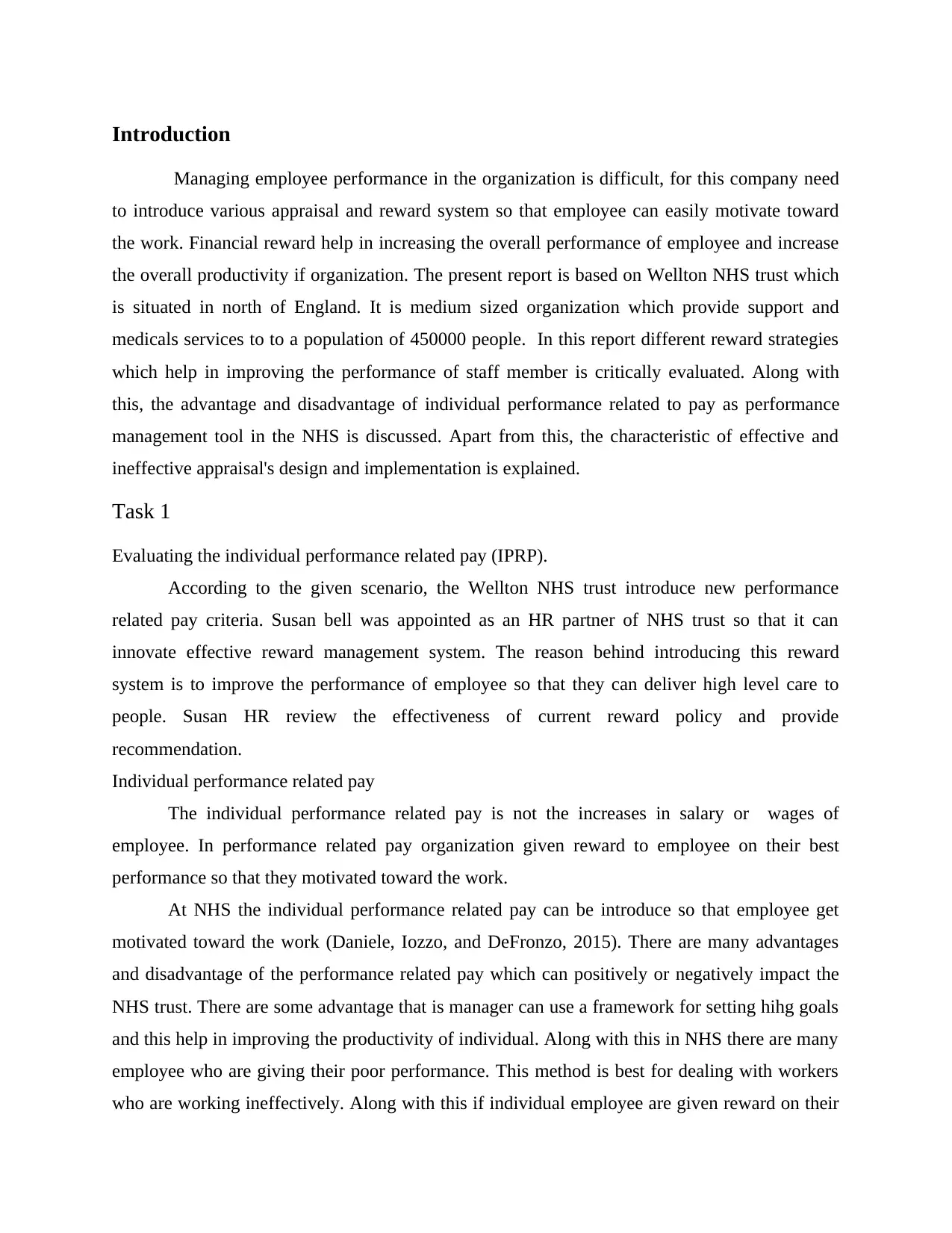
Introduction
Managing employee performance in the organization is difficult, for this company need
to introduce various appraisal and reward system so that employee can easily motivate toward
the work. Financial reward help in increasing the overall performance of employee and increase
the overall productivity if organization. The present report is based on Wellton NHS trust which
is situated in north of England. It is medium sized organization which provide support and
medicals services to to a population of 450000 people. In this report different reward strategies
which help in improving the performance of staff member is critically evaluated. Along with
this, the advantage and disadvantage of individual performance related to pay as performance
management tool in the NHS is discussed. Apart from this, the characteristic of effective and
ineffective appraisal's design and implementation is explained.
Task 1
Evaluating the individual performance related pay (IPRP).
According to the given scenario, the Wellton NHS trust introduce new performance
related pay criteria. Susan bell was appointed as an HR partner of NHS trust so that it can
innovate effective reward management system. The reason behind introducing this reward
system is to improve the performance of employee so that they can deliver high level care to
people. Susan HR review the effectiveness of current reward policy and provide
recommendation.
Individual performance related pay
The individual performance related pay is not the increases in salary or wages of
employee. In performance related pay organization given reward to employee on their best
performance so that they motivated toward the work.
At NHS the individual performance related pay can be introduce so that employee get
motivated toward the work (Daniele, Iozzo, and DeFronzo, 2015). There are many advantages
and disadvantage of the performance related pay which can positively or negatively impact the
NHS trust. There are some advantage that is manager can use a framework for setting hihg goals
and this help in improving the productivity of individual. Along with this in NHS there are many
employee who are giving their poor performance. This method is best for dealing with workers
who are working ineffectively. Along with this if individual employee are given reward on their
Managing employee performance in the organization is difficult, for this company need
to introduce various appraisal and reward system so that employee can easily motivate toward
the work. Financial reward help in increasing the overall performance of employee and increase
the overall productivity if organization. The present report is based on Wellton NHS trust which
is situated in north of England. It is medium sized organization which provide support and
medicals services to to a population of 450000 people. In this report different reward strategies
which help in improving the performance of staff member is critically evaluated. Along with
this, the advantage and disadvantage of individual performance related to pay as performance
management tool in the NHS is discussed. Apart from this, the characteristic of effective and
ineffective appraisal's design and implementation is explained.
Task 1
Evaluating the individual performance related pay (IPRP).
According to the given scenario, the Wellton NHS trust introduce new performance
related pay criteria. Susan bell was appointed as an HR partner of NHS trust so that it can
innovate effective reward management system. The reason behind introducing this reward
system is to improve the performance of employee so that they can deliver high level care to
people. Susan HR review the effectiveness of current reward policy and provide
recommendation.
Individual performance related pay
The individual performance related pay is not the increases in salary or wages of
employee. In performance related pay organization given reward to employee on their best
performance so that they motivated toward the work.
At NHS the individual performance related pay can be introduce so that employee get
motivated toward the work (Daniele, Iozzo, and DeFronzo, 2015). There are many advantages
and disadvantage of the performance related pay which can positively or negatively impact the
NHS trust. There are some advantage that is manager can use a framework for setting hihg goals
and this help in improving the productivity of individual. Along with this in NHS there are many
employee who are giving their poor performance. This method is best for dealing with workers
who are working ineffectively. Along with this if individual employee are given reward on their
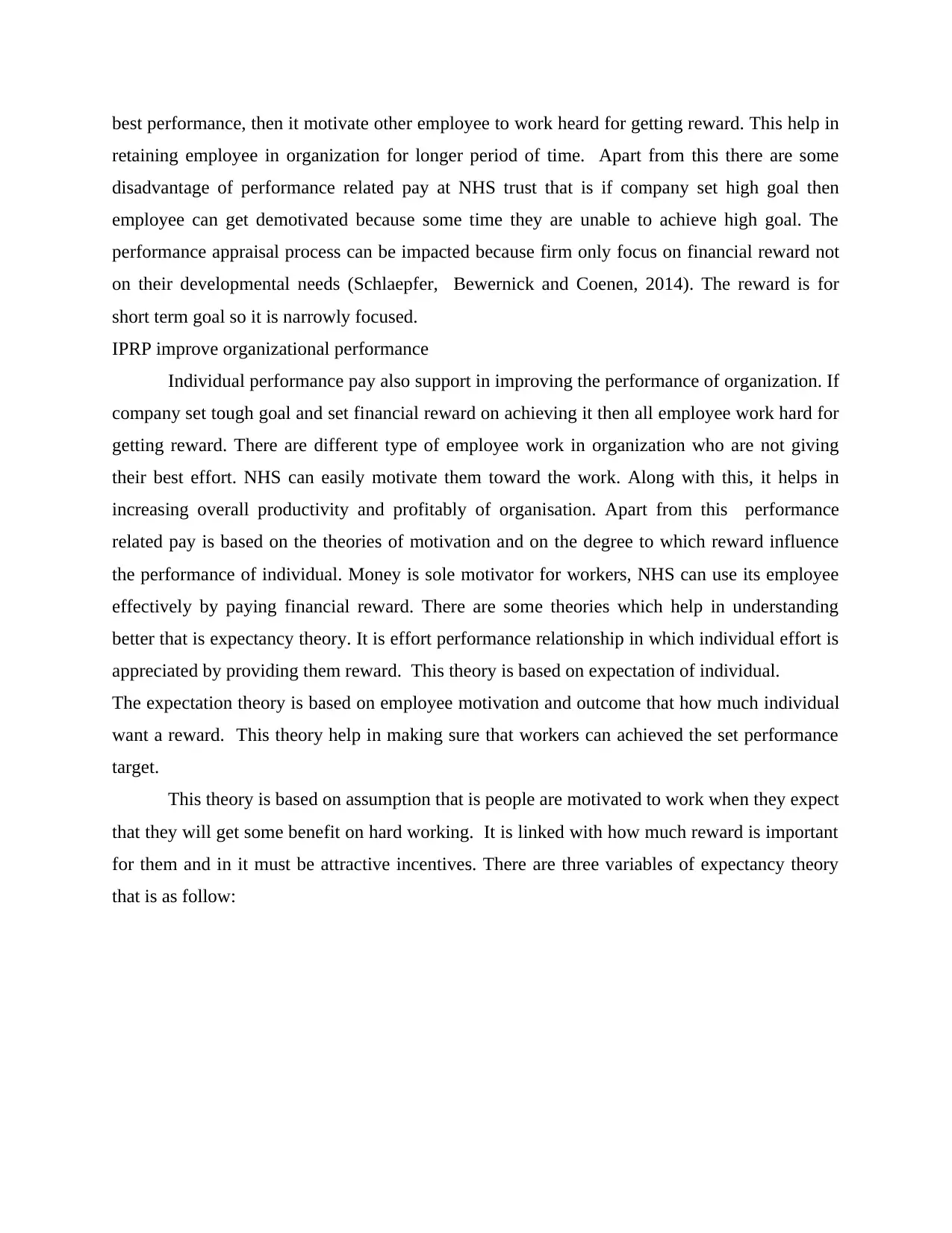
best performance, then it motivate other employee to work heard for getting reward. This help in
retaining employee in organization for longer period of time. Apart from this there are some
disadvantage of performance related pay at NHS trust that is if company set high goal then
employee can get demotivated because some time they are unable to achieve high goal. The
performance appraisal process can be impacted because firm only focus on financial reward not
on their developmental needs (Schlaepfer, Bewernick and Coenen, 2014). The reward is for
short term goal so it is narrowly focused.
IPRP improve organizational performance
Individual performance pay also support in improving the performance of organization. If
company set tough goal and set financial reward on achieving it then all employee work hard for
getting reward. There are different type of employee work in organization who are not giving
their best effort. NHS can easily motivate them toward the work. Along with this, it helps in
increasing overall productivity and profitably of organisation. Apart from this performance
related pay is based on the theories of motivation and on the degree to which reward influence
the performance of individual. Money is sole motivator for workers, NHS can use its employee
effectively by paying financial reward. There are some theories which help in understanding
better that is expectancy theory. It is effort performance relationship in which individual effort is
appreciated by providing them reward. This theory is based on expectation of individual.
The expectation theory is based on employee motivation and outcome that how much individual
want a reward. This theory help in making sure that workers can achieved the set performance
target.
This theory is based on assumption that is people are motivated to work when they expect
that they will get some benefit on hard working. It is linked with how much reward is important
for them and in it must be attractive incentives. There are three variables of expectancy theory
that is as follow:
retaining employee in organization for longer period of time. Apart from this there are some
disadvantage of performance related pay at NHS trust that is if company set high goal then
employee can get demotivated because some time they are unable to achieve high goal. The
performance appraisal process can be impacted because firm only focus on financial reward not
on their developmental needs (Schlaepfer, Bewernick and Coenen, 2014). The reward is for
short term goal so it is narrowly focused.
IPRP improve organizational performance
Individual performance pay also support in improving the performance of organization. If
company set tough goal and set financial reward on achieving it then all employee work hard for
getting reward. There are different type of employee work in organization who are not giving
their best effort. NHS can easily motivate them toward the work. Along with this, it helps in
increasing overall productivity and profitably of organisation. Apart from this performance
related pay is based on the theories of motivation and on the degree to which reward influence
the performance of individual. Money is sole motivator for workers, NHS can use its employee
effectively by paying financial reward. There are some theories which help in understanding
better that is expectancy theory. It is effort performance relationship in which individual effort is
appreciated by providing them reward. This theory is based on expectation of individual.
The expectation theory is based on employee motivation and outcome that how much individual
want a reward. This theory help in making sure that workers can achieved the set performance
target.
This theory is based on assumption that is people are motivated to work when they expect
that they will get some benefit on hard working. It is linked with how much reward is important
for them and in it must be attractive incentives. There are three variables of expectancy theory
that is as follow:
Secure Best Marks with AI Grader
Need help grading? Try our AI Grader for instant feedback on your assignments.
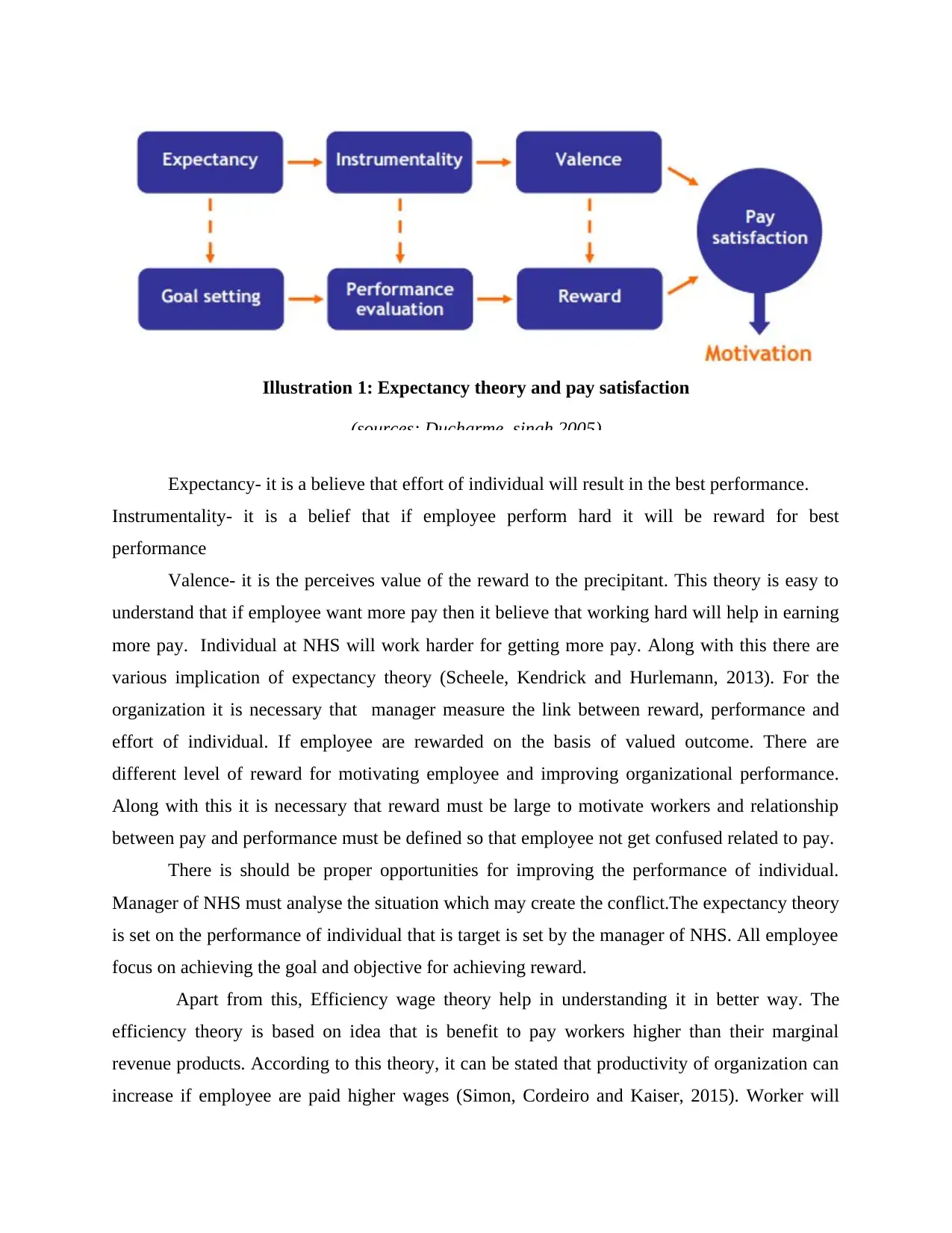
Expectancy- it is a believe that effort of individual will result in the best performance.
Instrumentality- it is a belief that if employee perform hard it will be reward for best
performance
Valence- it is the perceives value of the reward to the precipitant. This theory is easy to
understand that if employee want more pay then it believe that working hard will help in earning
more pay. Individual at NHS will work harder for getting more pay. Along with this there are
various implication of expectancy theory (Scheele, Kendrick and Hurlemann, 2013). For the
organization it is necessary that manager measure the link between reward, performance and
effort of individual. If employee are rewarded on the basis of valued outcome. There are
different level of reward for motivating employee and improving organizational performance.
Along with this it is necessary that reward must be large to motivate workers and relationship
between pay and performance must be defined so that employee not get confused related to pay.
There is should be proper opportunities for improving the performance of individual.
Manager of NHS must analyse the situation which may create the conflict.The expectancy theory
is set on the performance of individual that is target is set by the manager of NHS. All employee
focus on achieving the goal and objective for achieving reward.
Apart from this, Efficiency wage theory help in understanding it in better way. The
efficiency theory is based on idea that is benefit to pay workers higher than their marginal
revenue products. According to this theory, it can be stated that productivity of organization can
increase if employee are paid higher wages (Simon, Cordeiro and Kaiser, 2015). Worker will
Illustration 1: Expectancy theory and pay satisfaction
(sources: Ducharme, singh 2005)
Instrumentality- it is a belief that if employee perform hard it will be reward for best
performance
Valence- it is the perceives value of the reward to the precipitant. This theory is easy to
understand that if employee want more pay then it believe that working hard will help in earning
more pay. Individual at NHS will work harder for getting more pay. Along with this there are
various implication of expectancy theory (Scheele, Kendrick and Hurlemann, 2013). For the
organization it is necessary that manager measure the link between reward, performance and
effort of individual. If employee are rewarded on the basis of valued outcome. There are
different level of reward for motivating employee and improving organizational performance.
Along with this it is necessary that reward must be large to motivate workers and relationship
between pay and performance must be defined so that employee not get confused related to pay.
There is should be proper opportunities for improving the performance of individual.
Manager of NHS must analyse the situation which may create the conflict.The expectancy theory
is set on the performance of individual that is target is set by the manager of NHS. All employee
focus on achieving the goal and objective for achieving reward.
Apart from this, Efficiency wage theory help in understanding it in better way. The
efficiency theory is based on idea that is benefit to pay workers higher than their marginal
revenue products. According to this theory, it can be stated that productivity of organization can
increase if employee are paid higher wages (Simon, Cordeiro and Kaiser, 2015). Worker will
Illustration 1: Expectancy theory and pay satisfaction
(sources: Ducharme, singh 2005)
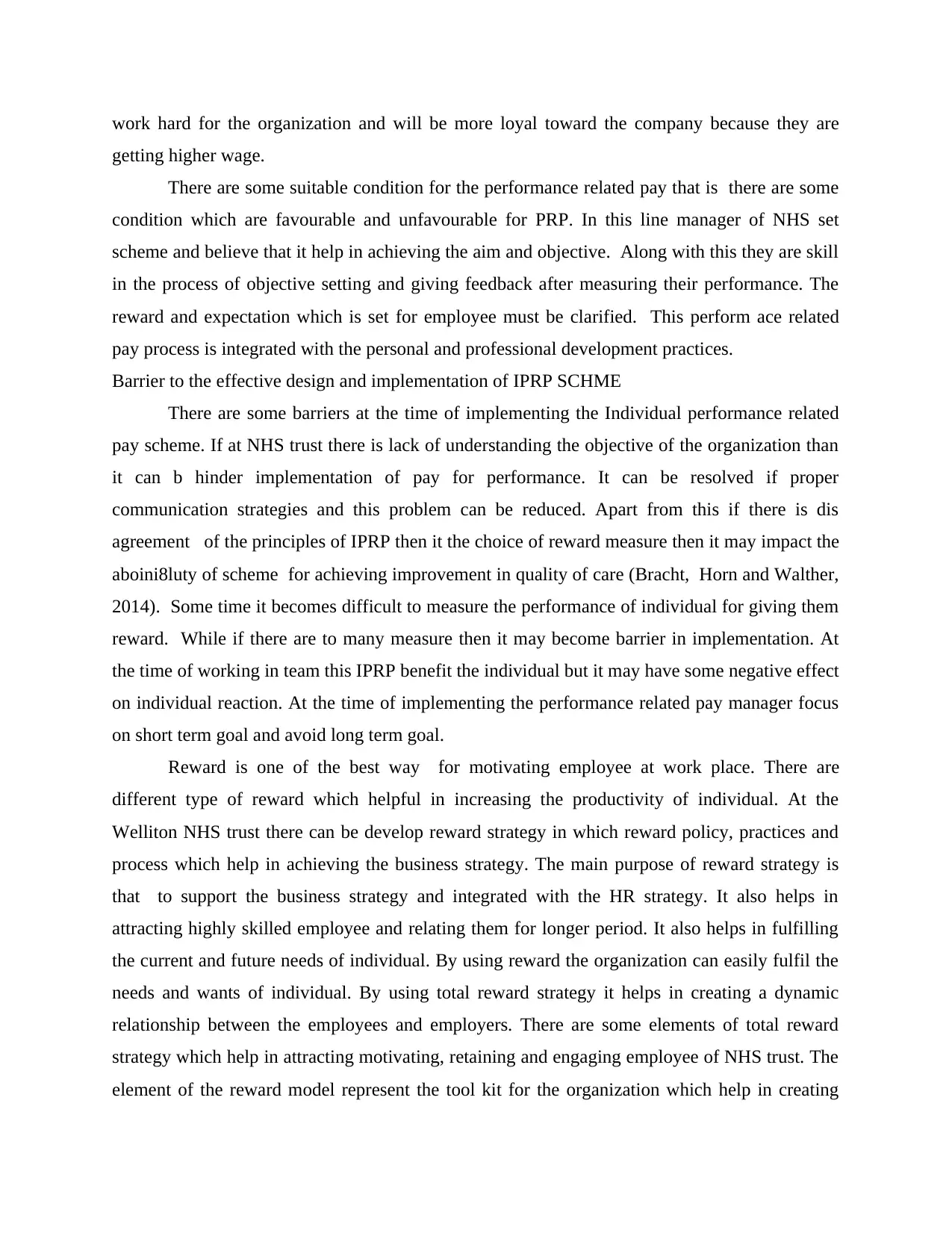
work hard for the organization and will be more loyal toward the company because they are
getting higher wage.
There are some suitable condition for the performance related pay that is there are some
condition which are favourable and unfavourable for PRP. In this line manager of NHS set
scheme and believe that it help in achieving the aim and objective. Along with this they are skill
in the process of objective setting and giving feedback after measuring their performance. The
reward and expectation which is set for employee must be clarified. This perform ace related
pay process is integrated with the personal and professional development practices.
Barrier to the effective design and implementation of IPRP SCHME
There are some barriers at the time of implementing the Individual performance related
pay scheme. If at NHS trust there is lack of understanding the objective of the organization than
it can b hinder implementation of pay for performance. It can be resolved if proper
communication strategies and this problem can be reduced. Apart from this if there is dis
agreement of the principles of IPRP then it the choice of reward measure then it may impact the
aboini8luty of scheme for achieving improvement in quality of care (Bracht, Horn and Walther,
2014). Some time it becomes difficult to measure the performance of individual for giving them
reward. While if there are to many measure then it may become barrier in implementation. At
the time of working in team this IPRP benefit the individual but it may have some negative effect
on individual reaction. At the time of implementing the performance related pay manager focus
on short term goal and avoid long term goal.
Reward is one of the best way for motivating employee at work place. There are
different type of reward which helpful in increasing the productivity of individual. At the
Welliton NHS trust there can be develop reward strategy in which reward policy, practices and
process which help in achieving the business strategy. The main purpose of reward strategy is
that to support the business strategy and integrated with the HR strategy. It also helps in
attracting highly skilled employee and relating them for longer period. It also helps in fulfilling
the current and future needs of individual. By using reward the organization can easily fulfil the
needs and wants of individual. By using total reward strategy it helps in creating a dynamic
relationship between the employees and employers. There are some elements of total reward
strategy which help in attracting motivating, retaining and engaging employee of NHS trust. The
element of the reward model represent the tool kit for the organization which help in creating
getting higher wage.
There are some suitable condition for the performance related pay that is there are some
condition which are favourable and unfavourable for PRP. In this line manager of NHS set
scheme and believe that it help in achieving the aim and objective. Along with this they are skill
in the process of objective setting and giving feedback after measuring their performance. The
reward and expectation which is set for employee must be clarified. This perform ace related
pay process is integrated with the personal and professional development practices.
Barrier to the effective design and implementation of IPRP SCHME
There are some barriers at the time of implementing the Individual performance related
pay scheme. If at NHS trust there is lack of understanding the objective of the organization than
it can b hinder implementation of pay for performance. It can be resolved if proper
communication strategies and this problem can be reduced. Apart from this if there is dis
agreement of the principles of IPRP then it the choice of reward measure then it may impact the
aboini8luty of scheme for achieving improvement in quality of care (Bracht, Horn and Walther,
2014). Some time it becomes difficult to measure the performance of individual for giving them
reward. While if there are to many measure then it may become barrier in implementation. At
the time of working in team this IPRP benefit the individual but it may have some negative effect
on individual reaction. At the time of implementing the performance related pay manager focus
on short term goal and avoid long term goal.
Reward is one of the best way for motivating employee at work place. There are
different type of reward which helpful in increasing the productivity of individual. At the
Welliton NHS trust there can be develop reward strategy in which reward policy, practices and
process which help in achieving the business strategy. The main purpose of reward strategy is
that to support the business strategy and integrated with the HR strategy. It also helps in
attracting highly skilled employee and relating them for longer period. It also helps in fulfilling
the current and future needs of individual. By using reward the organization can easily fulfil the
needs and wants of individual. By using total reward strategy it helps in creating a dynamic
relationship between the employees and employers. There are some elements of total reward
strategy which help in attracting motivating, retaining and engaging employee of NHS trust. The
element of the reward model represent the tool kit for the organization which help in creating
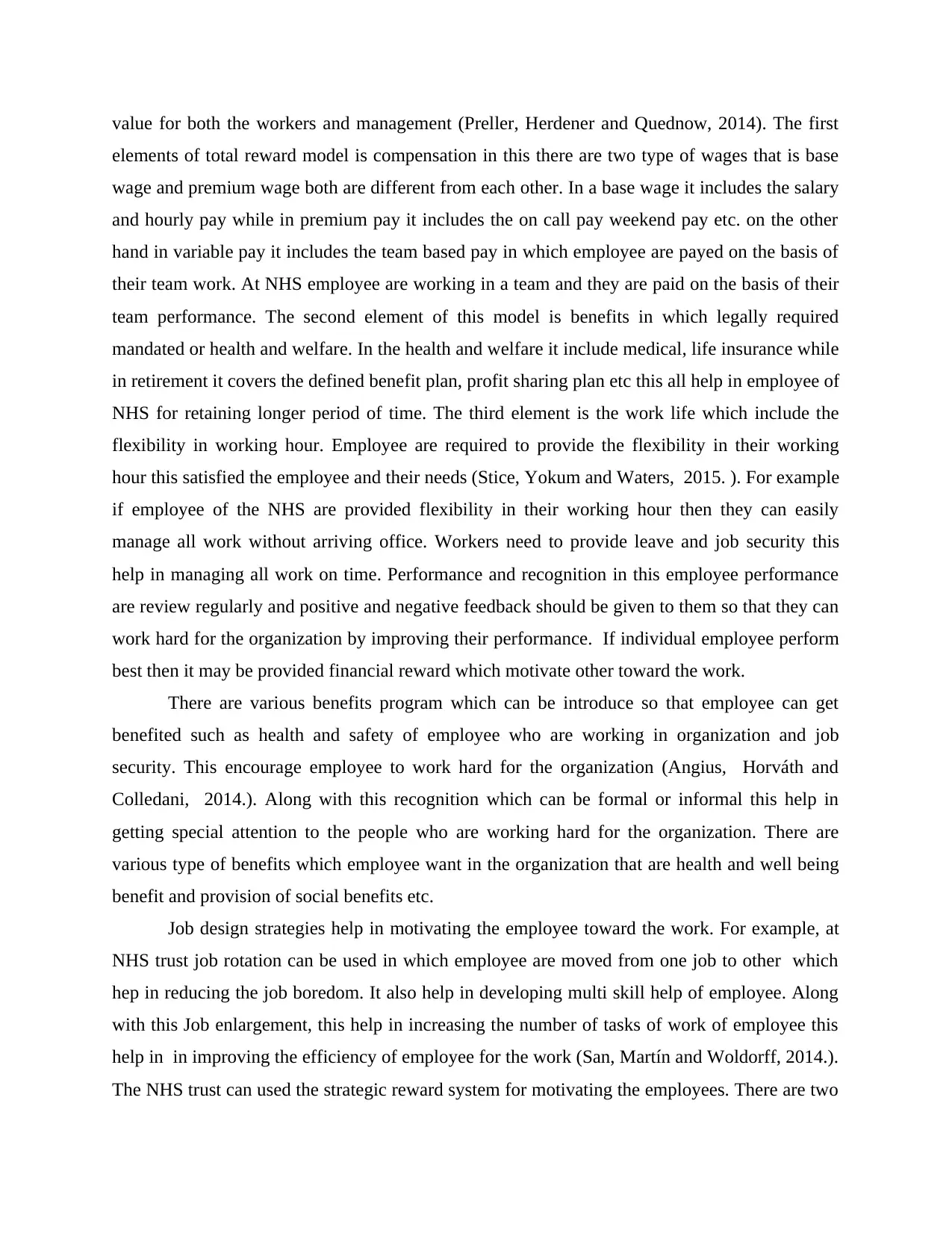
value for both the workers and management (Preller, Herdener and Quednow, 2014). The first
elements of total reward model is compensation in this there are two type of wages that is base
wage and premium wage both are different from each other. In a base wage it includes the salary
and hourly pay while in premium pay it includes the on call pay weekend pay etc. on the other
hand in variable pay it includes the team based pay in which employee are payed on the basis of
their team work. At NHS employee are working in a team and they are paid on the basis of their
team performance. The second element of this model is benefits in which legally required
mandated or health and welfare. In the health and welfare it include medical, life insurance while
in retirement it covers the defined benefit plan, profit sharing plan etc this all help in employee of
NHS for retaining longer period of time. The third element is the work life which include the
flexibility in working hour. Employee are required to provide the flexibility in their working
hour this satisfied the employee and their needs (Stice, Yokum and Waters, 2015. ). For example
if employee of the NHS are provided flexibility in their working hour then they can easily
manage all work without arriving office. Workers need to provide leave and job security this
help in managing all work on time. Performance and recognition in this employee performance
are review regularly and positive and negative feedback should be given to them so that they can
work hard for the organization by improving their performance. If individual employee perform
best then it may be provided financial reward which motivate other toward the work.
There are various benefits program which can be introduce so that employee can get
benefited such as health and safety of employee who are working in organization and job
security. This encourage employee to work hard for the organization (Angius, Horváth and
Colledani, 2014.). Along with this recognition which can be formal or informal this help in
getting special attention to the people who are working hard for the organization. There are
various type of benefits which employee want in the organization that are health and well being
benefit and provision of social benefits etc.
Job design strategies help in motivating the employee toward the work. For example, at
NHS trust job rotation can be used in which employee are moved from one job to other which
hep in reducing the job boredom. It also help in developing multi skill help of employee. Along
with this Job enlargement, this help in increasing the number of tasks of work of employee this
help in in improving the efficiency of employee for the work (San, Martín and Woldorff, 2014.).
The NHS trust can used the strategic reward system for motivating the employees. There are two
elements of total reward model is compensation in this there are two type of wages that is base
wage and premium wage both are different from each other. In a base wage it includes the salary
and hourly pay while in premium pay it includes the on call pay weekend pay etc. on the other
hand in variable pay it includes the team based pay in which employee are payed on the basis of
their team work. At NHS employee are working in a team and they are paid on the basis of their
team performance. The second element of this model is benefits in which legally required
mandated or health and welfare. In the health and welfare it include medical, life insurance while
in retirement it covers the defined benefit plan, profit sharing plan etc this all help in employee of
NHS for retaining longer period of time. The third element is the work life which include the
flexibility in working hour. Employee are required to provide the flexibility in their working
hour this satisfied the employee and their needs (Stice, Yokum and Waters, 2015. ). For example
if employee of the NHS are provided flexibility in their working hour then they can easily
manage all work without arriving office. Workers need to provide leave and job security this
help in managing all work on time. Performance and recognition in this employee performance
are review regularly and positive and negative feedback should be given to them so that they can
work hard for the organization by improving their performance. If individual employee perform
best then it may be provided financial reward which motivate other toward the work.
There are various benefits program which can be introduce so that employee can get
benefited such as health and safety of employee who are working in organization and job
security. This encourage employee to work hard for the organization (Angius, Horváth and
Colledani, 2014.). Along with this recognition which can be formal or informal this help in
getting special attention to the people who are working hard for the organization. There are
various type of benefits which employee want in the organization that are health and well being
benefit and provision of social benefits etc.
Job design strategies help in motivating the employee toward the work. For example, at
NHS trust job rotation can be used in which employee are moved from one job to other which
hep in reducing the job boredom. It also help in developing multi skill help of employee. Along
with this Job enlargement, this help in increasing the number of tasks of work of employee this
help in in improving the efficiency of employee for the work (San, Martín and Woldorff, 2014.).
The NHS trust can used the strategic reward system for motivating the employees. There are two
Paraphrase This Document
Need a fresh take? Get an instant paraphrase of this document with our AI Paraphraser
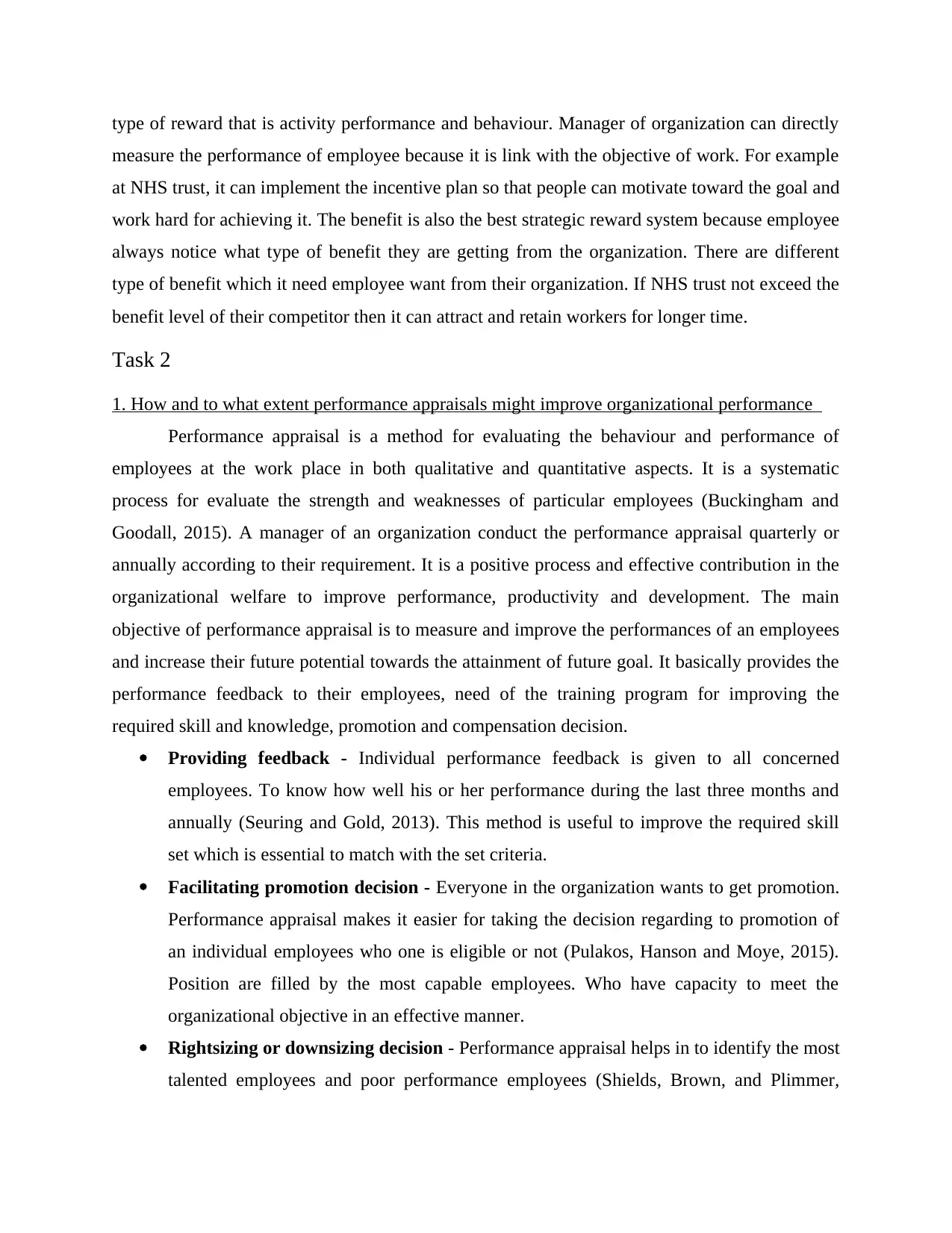
type of reward that is activity performance and behaviour. Manager of organization can directly
measure the performance of employee because it is link with the objective of work. For example
at NHS trust, it can implement the incentive plan so that people can motivate toward the goal and
work hard for achieving it. The benefit is also the best strategic reward system because employee
always notice what type of benefit they are getting from the organization. There are different
type of benefit which it need employee want from their organization. If NHS trust not exceed the
benefit level of their competitor then it can attract and retain workers for longer time.
Task 2
1. How and to what extent performance appraisals might improve organizational performance
Performance appraisal is a method for evaluating the behaviour and performance of
employees at the work place in both qualitative and quantitative aspects. It is a systematic
process for evaluate the strength and weaknesses of particular employees (Buckingham and
Goodall, 2015). A manager of an organization conduct the performance appraisal quarterly or
annually according to their requirement. It is a positive process and effective contribution in the
organizational welfare to improve performance, productivity and development. The main
objective of performance appraisal is to measure and improve the performances of an employees
and increase their future potential towards the attainment of future goal. It basically provides the
performance feedback to their employees, need of the training program for improving the
required skill and knowledge, promotion and compensation decision.
Providing feedback - Individual performance feedback is given to all concerned
employees. To know how well his or her performance during the last three months and
annually (Seuring and Gold, 2013). This method is useful to improve the required skill
set which is essential to match with the set criteria.
Facilitating promotion decision - Everyone in the organization wants to get promotion.
Performance appraisal makes it easier for taking the decision regarding to promotion of
an individual employees who one is eligible or not (Pulakos, Hanson and Moye, 2015).
Position are filled by the most capable employees. Who have capacity to meet the
organizational objective in an effective manner.
Rightsizing or downsizing decision - Performance appraisal helps in to identify the most
talented employees and poor performance employees (Shields, Brown, and Plimmer,
measure the performance of employee because it is link with the objective of work. For example
at NHS trust, it can implement the incentive plan so that people can motivate toward the goal and
work hard for achieving it. The benefit is also the best strategic reward system because employee
always notice what type of benefit they are getting from the organization. There are different
type of benefit which it need employee want from their organization. If NHS trust not exceed the
benefit level of their competitor then it can attract and retain workers for longer time.
Task 2
1. How and to what extent performance appraisals might improve organizational performance
Performance appraisal is a method for evaluating the behaviour and performance of
employees at the work place in both qualitative and quantitative aspects. It is a systematic
process for evaluate the strength and weaknesses of particular employees (Buckingham and
Goodall, 2015). A manager of an organization conduct the performance appraisal quarterly or
annually according to their requirement. It is a positive process and effective contribution in the
organizational welfare to improve performance, productivity and development. The main
objective of performance appraisal is to measure and improve the performances of an employees
and increase their future potential towards the attainment of future goal. It basically provides the
performance feedback to their employees, need of the training program for improving the
required skill and knowledge, promotion and compensation decision.
Providing feedback - Individual performance feedback is given to all concerned
employees. To know how well his or her performance during the last three months and
annually (Seuring and Gold, 2013). This method is useful to improve the required skill
set which is essential to match with the set criteria.
Facilitating promotion decision - Everyone in the organization wants to get promotion.
Performance appraisal makes it easier for taking the decision regarding to promotion of
an individual employees who one is eligible or not (Pulakos, Hanson and Moye, 2015).
Position are filled by the most capable employees. Who have capacity to meet the
organizational objective in an effective manner.
Rightsizing or downsizing decision - Performance appraisal helps in to identify the most
talented employees and poor performance employees (Shields, Brown, and Plimmer,
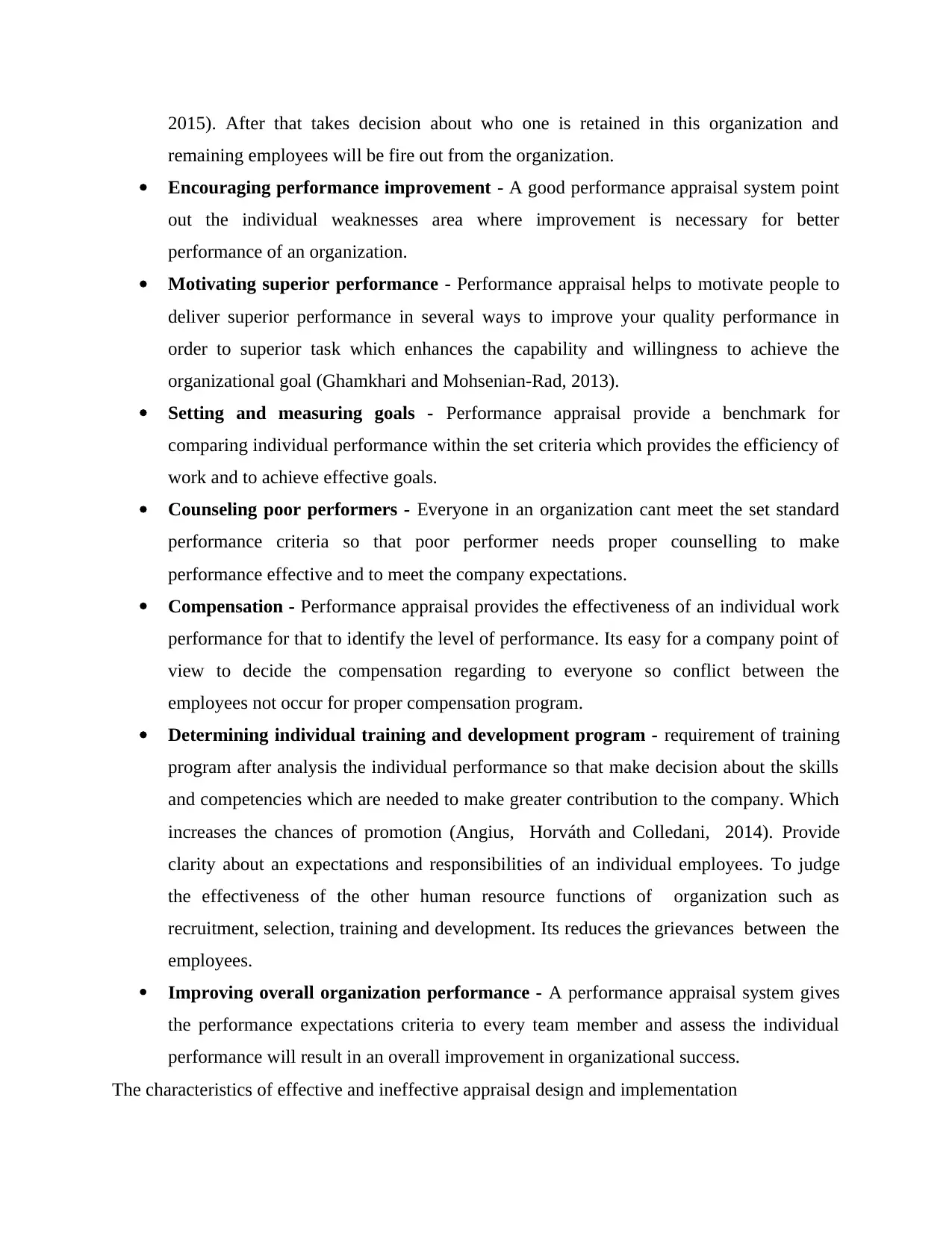
2015). After that takes decision about who one is retained in this organization and
remaining employees will be fire out from the organization.
Encouraging performance improvement - A good performance appraisal system point
out the individual weaknesses area where improvement is necessary for better
performance of an organization.
Motivating superior performance - Performance appraisal helps to motivate people to
deliver superior performance in several ways to improve your quality performance in
order to superior task which enhances the capability and willingness to achieve the
organizational goal (Ghamkhari and Mohsenian-Rad, 2013).
Setting and measuring goals - Performance appraisal provide a benchmark for
comparing individual performance within the set criteria which provides the efficiency of
work and to achieve effective goals.
Counseling poor performers - Everyone in an organization cant meet the set standard
performance criteria so that poor performer needs proper counselling to make
performance effective and to meet the company expectations.
Compensation - Performance appraisal provides the effectiveness of an individual work
performance for that to identify the level of performance. Its easy for a company point of
view to decide the compensation regarding to everyone so conflict between the
employees not occur for proper compensation program.
Determining individual training and development program - requirement of training
program after analysis the individual performance so that make decision about the skills
and competencies which are needed to make greater contribution to the company. Which
increases the chances of promotion (Angius, Horváth and Colledani, 2014). Provide
clarity about an expectations and responsibilities of an individual employees. To judge
the effectiveness of the other human resource functions of organization such as
recruitment, selection, training and development. Its reduces the grievances between the
employees.
Improving overall organization performance - A performance appraisal system gives
the performance expectations criteria to every team member and assess the individual
performance will result in an overall improvement in organizational success.
The characteristics of effective and ineffective appraisal design and implementation
remaining employees will be fire out from the organization.
Encouraging performance improvement - A good performance appraisal system point
out the individual weaknesses area where improvement is necessary for better
performance of an organization.
Motivating superior performance - Performance appraisal helps to motivate people to
deliver superior performance in several ways to improve your quality performance in
order to superior task which enhances the capability and willingness to achieve the
organizational goal (Ghamkhari and Mohsenian-Rad, 2013).
Setting and measuring goals - Performance appraisal provide a benchmark for
comparing individual performance within the set criteria which provides the efficiency of
work and to achieve effective goals.
Counseling poor performers - Everyone in an organization cant meet the set standard
performance criteria so that poor performer needs proper counselling to make
performance effective and to meet the company expectations.
Compensation - Performance appraisal provides the effectiveness of an individual work
performance for that to identify the level of performance. Its easy for a company point of
view to decide the compensation regarding to everyone so conflict between the
employees not occur for proper compensation program.
Determining individual training and development program - requirement of training
program after analysis the individual performance so that make decision about the skills
and competencies which are needed to make greater contribution to the company. Which
increases the chances of promotion (Angius, Horváth and Colledani, 2014). Provide
clarity about an expectations and responsibilities of an individual employees. To judge
the effectiveness of the other human resource functions of organization such as
recruitment, selection, training and development. Its reduces the grievances between the
employees.
Improving overall organization performance - A performance appraisal system gives
the performance expectations criteria to every team member and assess the individual
performance will result in an overall improvement in organizational success.
The characteristics of effective and ineffective appraisal design and implementation
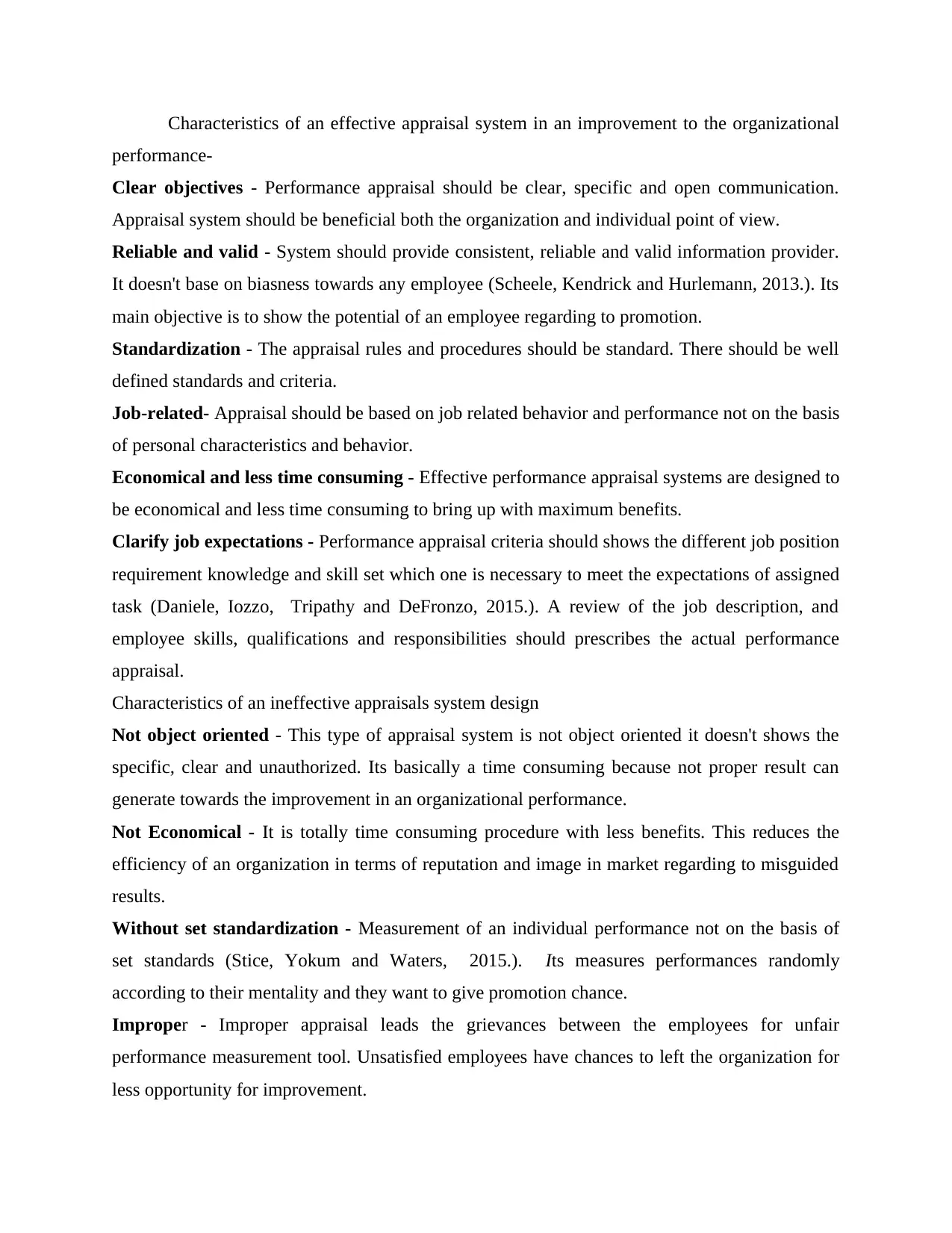
Characteristics of an effective appraisal system in an improvement to the organizational
performance-
Clear objectives - Performance appraisal should be clear, specific and open communication.
Appraisal system should be beneficial both the organization and individual point of view.
Reliable and valid - System should provide consistent, reliable and valid information provider.
It doesn't base on biasness towards any employee (Scheele, Kendrick and Hurlemann, 2013.). Its
main objective is to show the potential of an employee regarding to promotion.
Standardization - The appraisal rules and procedures should be standard. There should be well
defined standards and criteria.
Job-related- Appraisal should be based on job related behavior and performance not on the basis
of personal characteristics and behavior.
Economical and less time consuming - Effective performance appraisal systems are designed to
be economical and less time consuming to bring up with maximum benefits.
Clarify job expectations - Performance appraisal criteria should shows the different job position
requirement knowledge and skill set which one is necessary to meet the expectations of assigned
task (Daniele, Iozzo, Tripathy and DeFronzo, 2015.). A review of the job description, and
employee skills, qualifications and responsibilities should prescribes the actual performance
appraisal.
Characteristics of an ineffective appraisals system design
Not object oriented - This type of appraisal system is not object oriented it doesn't shows the
specific, clear and unauthorized. Its basically a time consuming because not proper result can
generate towards the improvement in an organizational performance.
Not Economical - It is totally time consuming procedure with less benefits. This reduces the
efficiency of an organization in terms of reputation and image in market regarding to misguided
results.
Without set standardization - Measurement of an individual performance not on the basis of
set standards (Stice, Yokum and Waters, 2015.). Its measures performances randomly
according to their mentality and they want to give promotion chance.
Improper - Improper appraisal leads the grievances between the employees for unfair
performance measurement tool. Unsatisfied employees have chances to left the organization for
less opportunity for improvement.
performance-
Clear objectives - Performance appraisal should be clear, specific and open communication.
Appraisal system should be beneficial both the organization and individual point of view.
Reliable and valid - System should provide consistent, reliable and valid information provider.
It doesn't base on biasness towards any employee (Scheele, Kendrick and Hurlemann, 2013.). Its
main objective is to show the potential of an employee regarding to promotion.
Standardization - The appraisal rules and procedures should be standard. There should be well
defined standards and criteria.
Job-related- Appraisal should be based on job related behavior and performance not on the basis
of personal characteristics and behavior.
Economical and less time consuming - Effective performance appraisal systems are designed to
be economical and less time consuming to bring up with maximum benefits.
Clarify job expectations - Performance appraisal criteria should shows the different job position
requirement knowledge and skill set which one is necessary to meet the expectations of assigned
task (Daniele, Iozzo, Tripathy and DeFronzo, 2015.). A review of the job description, and
employee skills, qualifications and responsibilities should prescribes the actual performance
appraisal.
Characteristics of an ineffective appraisals system design
Not object oriented - This type of appraisal system is not object oriented it doesn't shows the
specific, clear and unauthorized. Its basically a time consuming because not proper result can
generate towards the improvement in an organizational performance.
Not Economical - It is totally time consuming procedure with less benefits. This reduces the
efficiency of an organization in terms of reputation and image in market regarding to misguided
results.
Without set standardization - Measurement of an individual performance not on the basis of
set standards (Stice, Yokum and Waters, 2015.). Its measures performances randomly
according to their mentality and they want to give promotion chance.
Improper - Improper appraisal leads the grievances between the employees for unfair
performance measurement tool. Unsatisfied employees have chances to left the organization for
less opportunity for improvement.
Secure Best Marks with AI Grader
Need help grading? Try our AI Grader for instant feedback on your assignments.
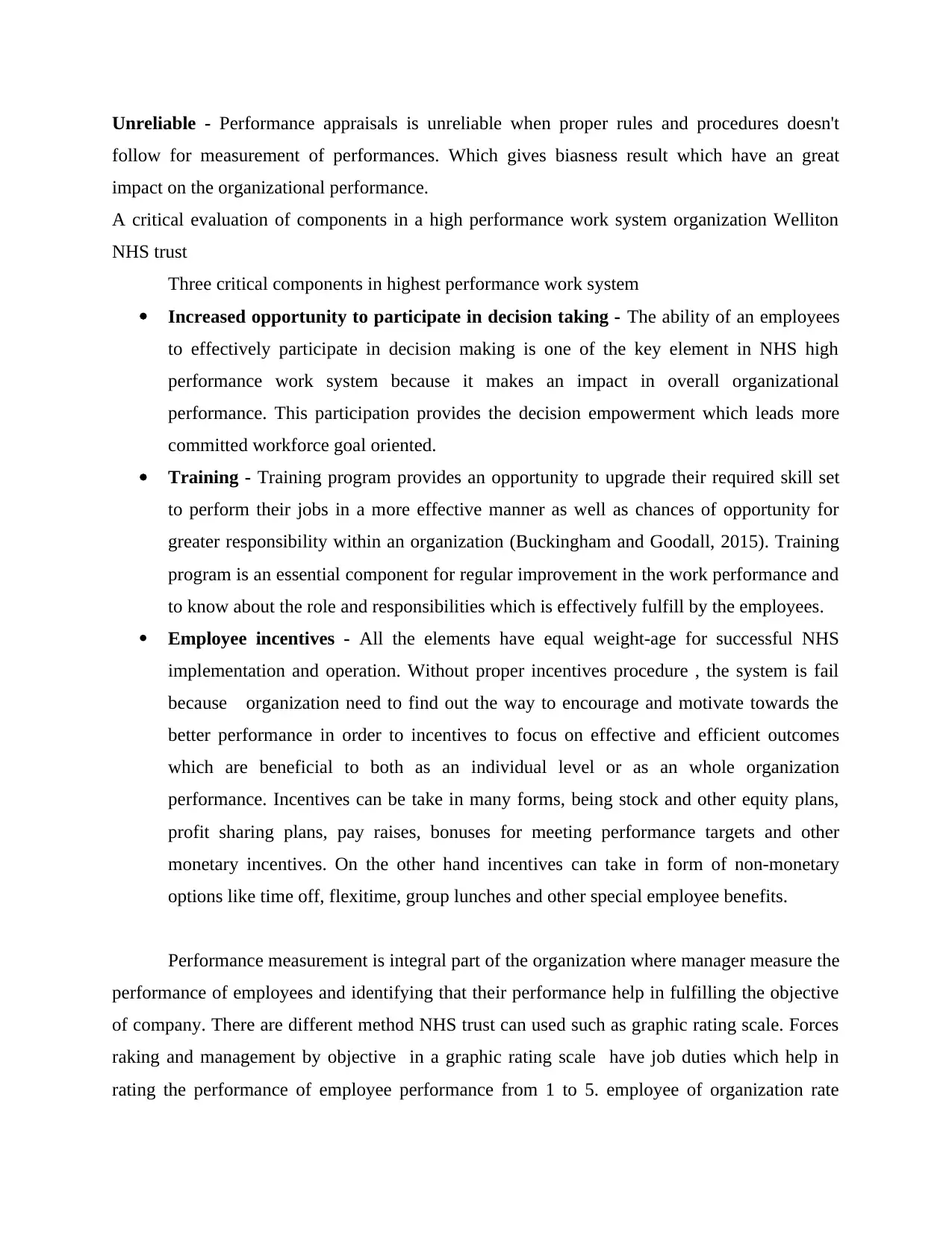
Unreliable - Performance appraisals is unreliable when proper rules and procedures doesn't
follow for measurement of performances. Which gives biasness result which have an great
impact on the organizational performance.
A critical evaluation of components in a high performance work system organization Welliton
NHS trust
Three critical components in highest performance work system
Increased opportunity to participate in decision taking - The ability of an employees
to effectively participate in decision making is one of the key element in NHS high
performance work system because it makes an impact in overall organizational
performance. This participation provides the decision empowerment which leads more
committed workforce goal oriented.
Training - Training program provides an opportunity to upgrade their required skill set
to perform their jobs in a more effective manner as well as chances of opportunity for
greater responsibility within an organization (Buckingham and Goodall, 2015). Training
program is an essential component for regular improvement in the work performance and
to know about the role and responsibilities which is effectively fulfill by the employees.
Employee incentives - All the elements have equal weight-age for successful NHS
implementation and operation. Without proper incentives procedure , the system is fail
because organization need to find out the way to encourage and motivate towards the
better performance in order to incentives to focus on effective and efficient outcomes
which are beneficial to both as an individual level or as an whole organization
performance. Incentives can be take in many forms, being stock and other equity plans,
profit sharing plans, pay raises, bonuses for meeting performance targets and other
monetary incentives. On the other hand incentives can take in form of non-monetary
options like time off, flexitime, group lunches and other special employee benefits.
Performance measurement is integral part of the organization where manager measure the
performance of employees and identifying that their performance help in fulfilling the objective
of company. There are different method NHS trust can used such as graphic rating scale. Forces
raking and management by objective in a graphic rating scale have job duties which help in
rating the performance of employee performance from 1 to 5. employee of organization rate
follow for measurement of performances. Which gives biasness result which have an great
impact on the organizational performance.
A critical evaluation of components in a high performance work system organization Welliton
NHS trust
Three critical components in highest performance work system
Increased opportunity to participate in decision taking - The ability of an employees
to effectively participate in decision making is one of the key element in NHS high
performance work system because it makes an impact in overall organizational
performance. This participation provides the decision empowerment which leads more
committed workforce goal oriented.
Training - Training program provides an opportunity to upgrade their required skill set
to perform their jobs in a more effective manner as well as chances of opportunity for
greater responsibility within an organization (Buckingham and Goodall, 2015). Training
program is an essential component for regular improvement in the work performance and
to know about the role and responsibilities which is effectively fulfill by the employees.
Employee incentives - All the elements have equal weight-age for successful NHS
implementation and operation. Without proper incentives procedure , the system is fail
because organization need to find out the way to encourage and motivate towards the
better performance in order to incentives to focus on effective and efficient outcomes
which are beneficial to both as an individual level or as an whole organization
performance. Incentives can be take in many forms, being stock and other equity plans,
profit sharing plans, pay raises, bonuses for meeting performance targets and other
monetary incentives. On the other hand incentives can take in form of non-monetary
options like time off, flexitime, group lunches and other special employee benefits.
Performance measurement is integral part of the organization where manager measure the
performance of employees and identifying that their performance help in fulfilling the objective
of company. There are different method NHS trust can used such as graphic rating scale. Forces
raking and management by objective in a graphic rating scale have job duties which help in
rating the performance of employee performance from 1 to 5. employee of organization rate
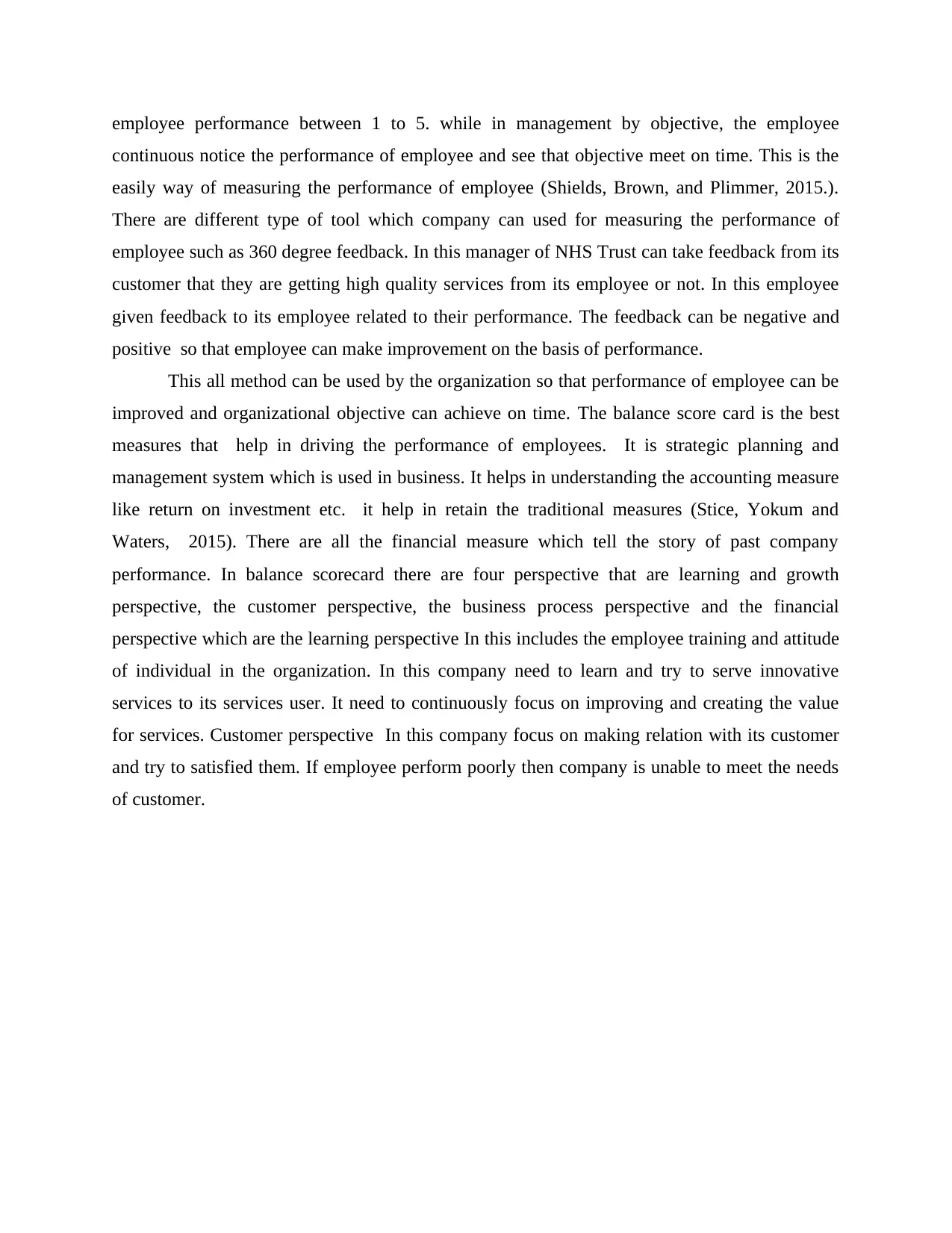
employee performance between 1 to 5. while in management by objective, the employee
continuous notice the performance of employee and see that objective meet on time. This is the
easily way of measuring the performance of employee (Shields, Brown, and Plimmer, 2015.).
There are different type of tool which company can used for measuring the performance of
employee such as 360 degree feedback. In this manager of NHS Trust can take feedback from its
customer that they are getting high quality services from its employee or not. In this employee
given feedback to its employee related to their performance. The feedback can be negative and
positive so that employee can make improvement on the basis of performance.
This all method can be used by the organization so that performance of employee can be
improved and organizational objective can achieve on time. The balance score card is the best
measures that help in driving the performance of employees. It is strategic planning and
management system which is used in business. It helps in understanding the accounting measure
like return on investment etc. it help in retain the traditional measures (Stice, Yokum and
Waters, 2015). There are all the financial measure which tell the story of past company
performance. In balance scorecard there are four perspective that are learning and growth
perspective, the customer perspective, the business process perspective and the financial
perspective which are the learning perspective In this includes the employee training and attitude
of individual in the organization. In this company need to learn and try to serve innovative
services to its services user. It need to continuously focus on improving and creating the value
for services. Customer perspective In this company focus on making relation with its customer
and try to satisfied them. If employee perform poorly then company is unable to meet the needs
of customer.
continuous notice the performance of employee and see that objective meet on time. This is the
easily way of measuring the performance of employee (Shields, Brown, and Plimmer, 2015.).
There are different type of tool which company can used for measuring the performance of
employee such as 360 degree feedback. In this manager of NHS Trust can take feedback from its
customer that they are getting high quality services from its employee or not. In this employee
given feedback to its employee related to their performance. The feedback can be negative and
positive so that employee can make improvement on the basis of performance.
This all method can be used by the organization so that performance of employee can be
improved and organizational objective can achieve on time. The balance score card is the best
measures that help in driving the performance of employees. It is strategic planning and
management system which is used in business. It helps in understanding the accounting measure
like return on investment etc. it help in retain the traditional measures (Stice, Yokum and
Waters, 2015). There are all the financial measure which tell the story of past company
performance. In balance scorecard there are four perspective that are learning and growth
perspective, the customer perspective, the business process perspective and the financial
perspective which are the learning perspective In this includes the employee training and attitude
of individual in the organization. In this company need to learn and try to serve innovative
services to its services user. It need to continuously focus on improving and creating the value
for services. Customer perspective In this company focus on making relation with its customer
and try to satisfied them. If employee perform poorly then company is unable to meet the needs
of customer.
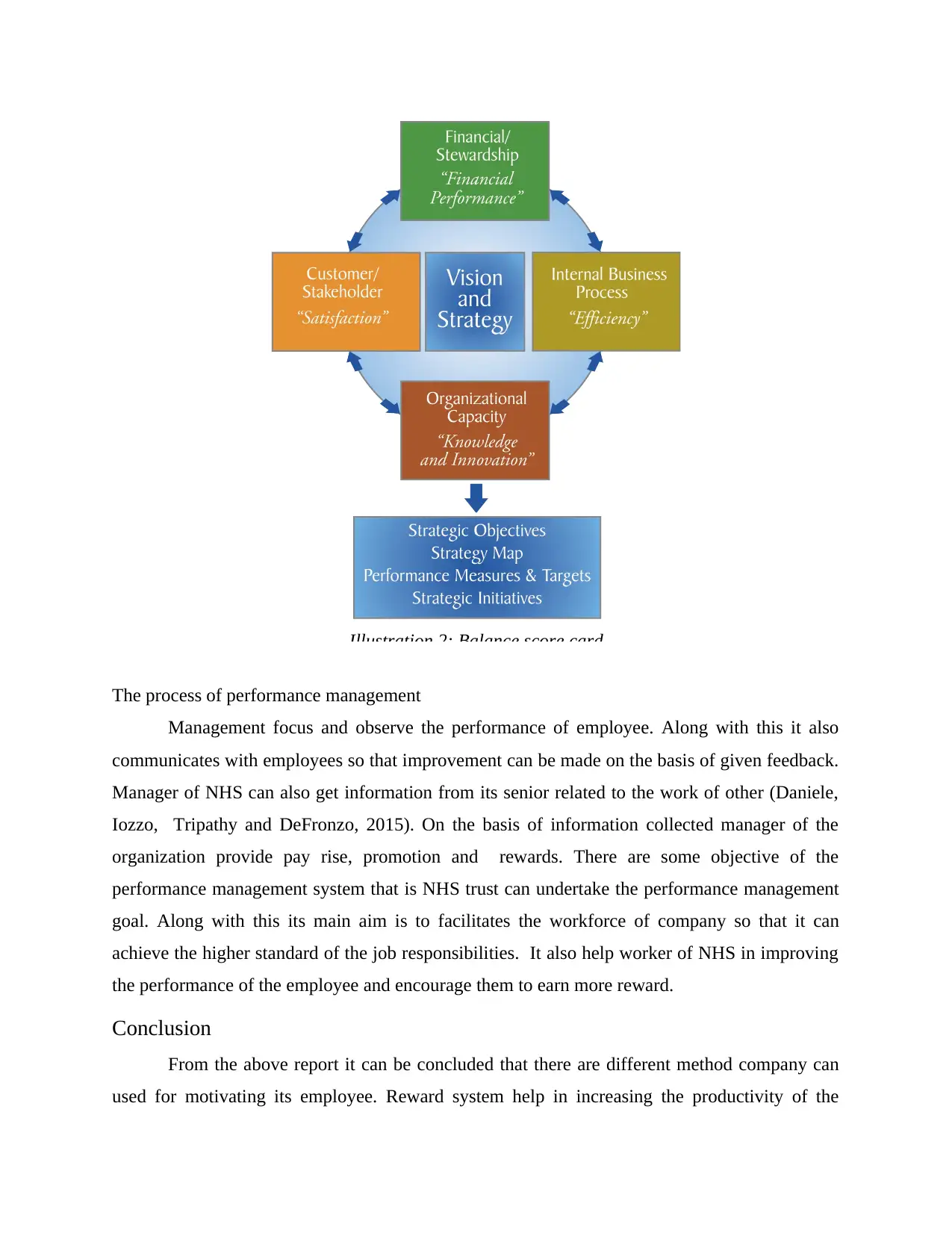
The process of performance management
Management focus and observe the performance of employee. Along with this it also
communicates with employees so that improvement can be made on the basis of given feedback.
Manager of NHS can also get information from its senior related to the work of other (Daniele,
Iozzo, Tripathy and DeFronzo, 2015). On the basis of information collected manager of the
organization provide pay rise, promotion and rewards. There are some objective of the
performance management system that is NHS trust can undertake the performance management
goal. Along with this its main aim is to facilitates the workforce of company so that it can
achieve the higher standard of the job responsibilities. It also help worker of NHS in improving
the performance of the employee and encourage them to earn more reward.
Conclusion
From the above report it can be concluded that there are different method company can
used for motivating its employee. Reward system help in increasing the productivity of the
Illustration 2: Balance score card
Management focus and observe the performance of employee. Along with this it also
communicates with employees so that improvement can be made on the basis of given feedback.
Manager of NHS can also get information from its senior related to the work of other (Daniele,
Iozzo, Tripathy and DeFronzo, 2015). On the basis of information collected manager of the
organization provide pay rise, promotion and rewards. There are some objective of the
performance management system that is NHS trust can undertake the performance management
goal. Along with this its main aim is to facilitates the workforce of company so that it can
achieve the higher standard of the job responsibilities. It also help worker of NHS in improving
the performance of the employee and encourage them to earn more reward.
Conclusion
From the above report it can be concluded that there are different method company can
used for motivating its employee. Reward system help in increasing the productivity of the
Illustration 2: Balance score card
Paraphrase This Document
Need a fresh take? Get an instant paraphrase of this document with our AI Paraphraser
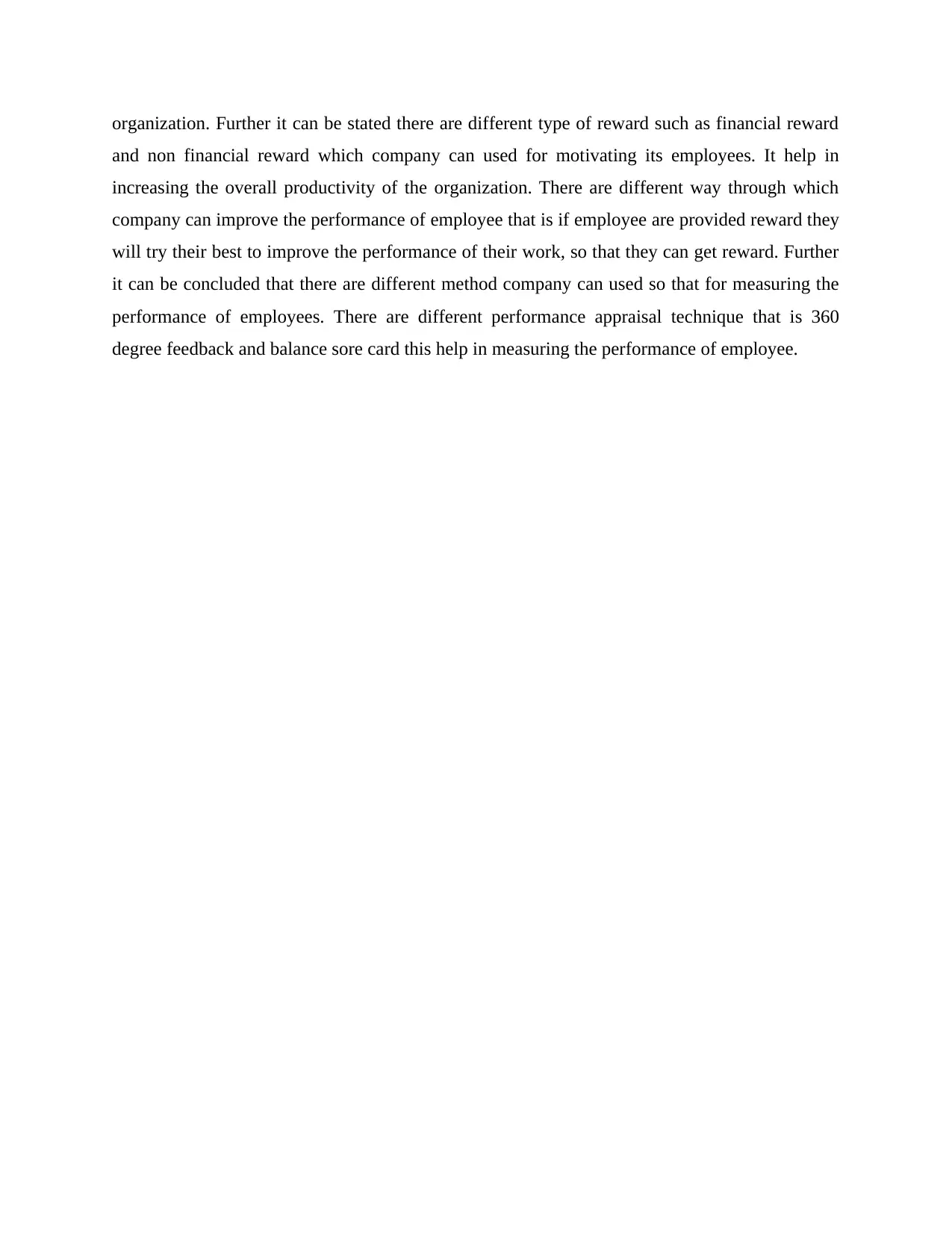
organization. Further it can be stated there are different type of reward such as financial reward
and non financial reward which company can used for motivating its employees. It help in
increasing the overall productivity of the organization. There are different way through which
company can improve the performance of employee that is if employee are provided reward they
will try their best to improve the performance of their work, so that they can get reward. Further
it can be concluded that there are different method company can used so that for measuring the
performance of employees. There are different performance appraisal technique that is 360
degree feedback and balance sore card this help in measuring the performance of employee.
and non financial reward which company can used for motivating its employees. It help in
increasing the overall productivity of the organization. There are different way through which
company can improve the performance of employee that is if employee are provided reward they
will try their best to improve the performance of their work, so that they can get reward. Further
it can be concluded that there are different method company can used so that for measuring the
performance of employees. There are different performance appraisal technique that is 360
degree feedback and balance sore card this help in measuring the performance of employee.
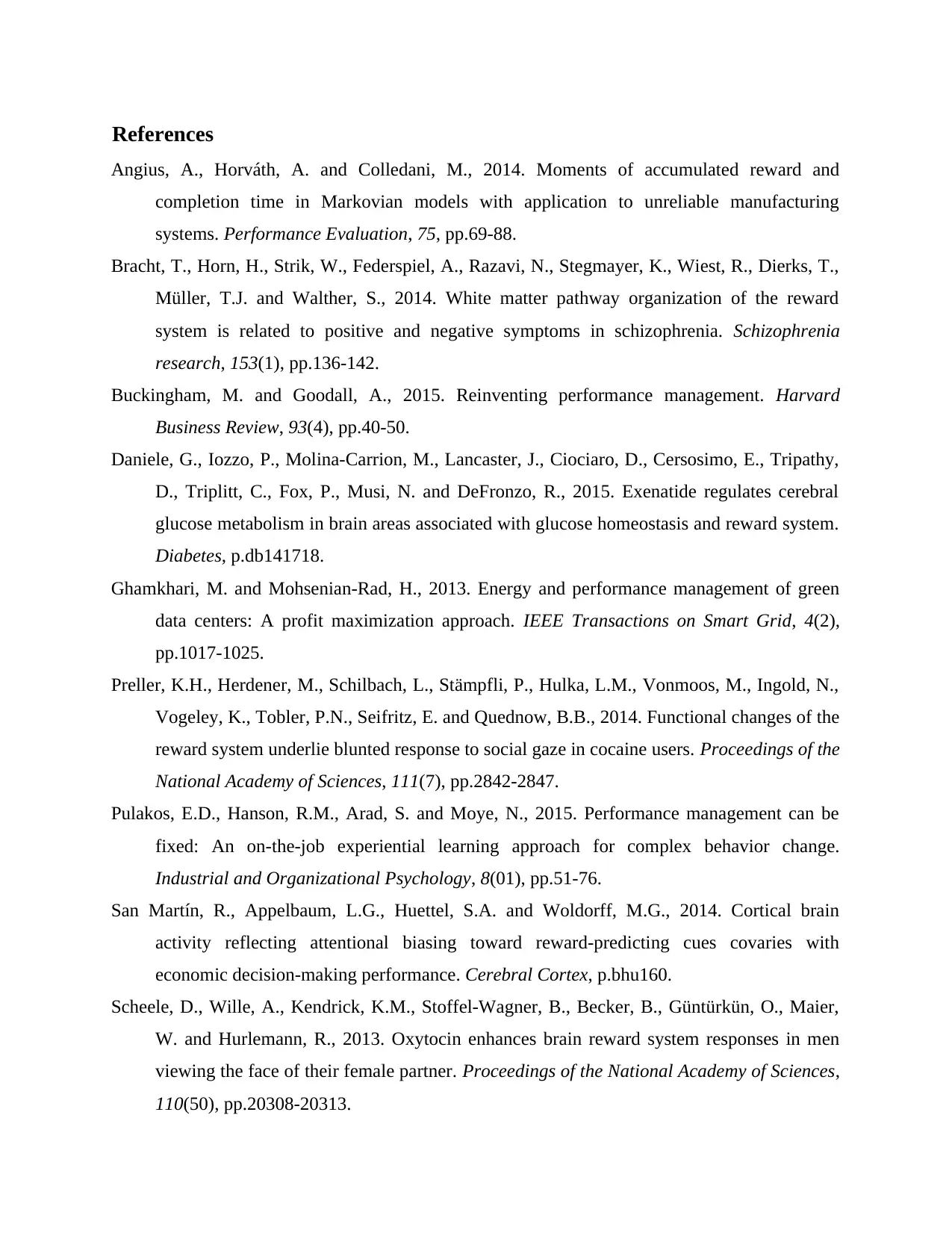
References
Angius, A., Horváth, A. and Colledani, M., 2014. Moments of accumulated reward and
completion time in Markovian models with application to unreliable manufacturing
systems. Performance Evaluation, 75, pp.69-88.
Bracht, T., Horn, H., Strik, W., Federspiel, A., Razavi, N., Stegmayer, K., Wiest, R., Dierks, T.,
Müller, T.J. and Walther, S., 2014. White matter pathway organization of the reward
system is related to positive and negative symptoms in schizophrenia. Schizophrenia
research, 153(1), pp.136-142.
Buckingham, M. and Goodall, A., 2015. Reinventing performance management. Harvard
Business Review, 93(4), pp.40-50.
Daniele, G., Iozzo, P., Molina-Carrion, M., Lancaster, J., Ciociaro, D., Cersosimo, E., Tripathy,
D., Triplitt, C., Fox, P., Musi, N. and DeFronzo, R., 2015. Exenatide regulates cerebral
glucose metabolism in brain areas associated with glucose homeostasis and reward system.
Diabetes, p.db141718.
Ghamkhari, M. and Mohsenian-Rad, H., 2013. Energy and performance management of green
data centers: A profit maximization approach. IEEE Transactions on Smart Grid, 4(2),
pp.1017-1025.
Preller, K.H., Herdener, M., Schilbach, L., Stämpfli, P., Hulka, L.M., Vonmoos, M., Ingold, N.,
Vogeley, K., Tobler, P.N., Seifritz, E. and Quednow, B.B., 2014. Functional changes of the
reward system underlie blunted response to social gaze in cocaine users. Proceedings of the
National Academy of Sciences, 111(7), pp.2842-2847.
Pulakos, E.D., Hanson, R.M., Arad, S. and Moye, N., 2015. Performance management can be
fixed: An on-the-job experiential learning approach for complex behavior change.
Industrial and Organizational Psychology, 8(01), pp.51-76.
San Martín, R., Appelbaum, L.G., Huettel, S.A. and Woldorff, M.G., 2014. Cortical brain
activity reflecting attentional biasing toward reward-predicting cues covaries with
economic decision-making performance. Cerebral Cortex, p.bhu160.
Scheele, D., Wille, A., Kendrick, K.M., Stoffel-Wagner, B., Becker, B., Güntürkün, O., Maier,
W. and Hurlemann, R., 2013. Oxytocin enhances brain reward system responses in men
viewing the face of their female partner. Proceedings of the National Academy of Sciences,
110(50), pp.20308-20313.
Angius, A., Horváth, A. and Colledani, M., 2014. Moments of accumulated reward and
completion time in Markovian models with application to unreliable manufacturing
systems. Performance Evaluation, 75, pp.69-88.
Bracht, T., Horn, H., Strik, W., Federspiel, A., Razavi, N., Stegmayer, K., Wiest, R., Dierks, T.,
Müller, T.J. and Walther, S., 2014. White matter pathway organization of the reward
system is related to positive and negative symptoms in schizophrenia. Schizophrenia
research, 153(1), pp.136-142.
Buckingham, M. and Goodall, A., 2015. Reinventing performance management. Harvard
Business Review, 93(4), pp.40-50.
Daniele, G., Iozzo, P., Molina-Carrion, M., Lancaster, J., Ciociaro, D., Cersosimo, E., Tripathy,
D., Triplitt, C., Fox, P., Musi, N. and DeFronzo, R., 2015. Exenatide regulates cerebral
glucose metabolism in brain areas associated with glucose homeostasis and reward system.
Diabetes, p.db141718.
Ghamkhari, M. and Mohsenian-Rad, H., 2013. Energy and performance management of green
data centers: A profit maximization approach. IEEE Transactions on Smart Grid, 4(2),
pp.1017-1025.
Preller, K.H., Herdener, M., Schilbach, L., Stämpfli, P., Hulka, L.M., Vonmoos, M., Ingold, N.,
Vogeley, K., Tobler, P.N., Seifritz, E. and Quednow, B.B., 2014. Functional changes of the
reward system underlie blunted response to social gaze in cocaine users. Proceedings of the
National Academy of Sciences, 111(7), pp.2842-2847.
Pulakos, E.D., Hanson, R.M., Arad, S. and Moye, N., 2015. Performance management can be
fixed: An on-the-job experiential learning approach for complex behavior change.
Industrial and Organizational Psychology, 8(01), pp.51-76.
San Martín, R., Appelbaum, L.G., Huettel, S.A. and Woldorff, M.G., 2014. Cortical brain
activity reflecting attentional biasing toward reward-predicting cues covaries with
economic decision-making performance. Cerebral Cortex, p.bhu160.
Scheele, D., Wille, A., Kendrick, K.M., Stoffel-Wagner, B., Becker, B., Güntürkün, O., Maier,
W. and Hurlemann, R., 2013. Oxytocin enhances brain reward system responses in men
viewing the face of their female partner. Proceedings of the National Academy of Sciences,
110(50), pp.20308-20313.
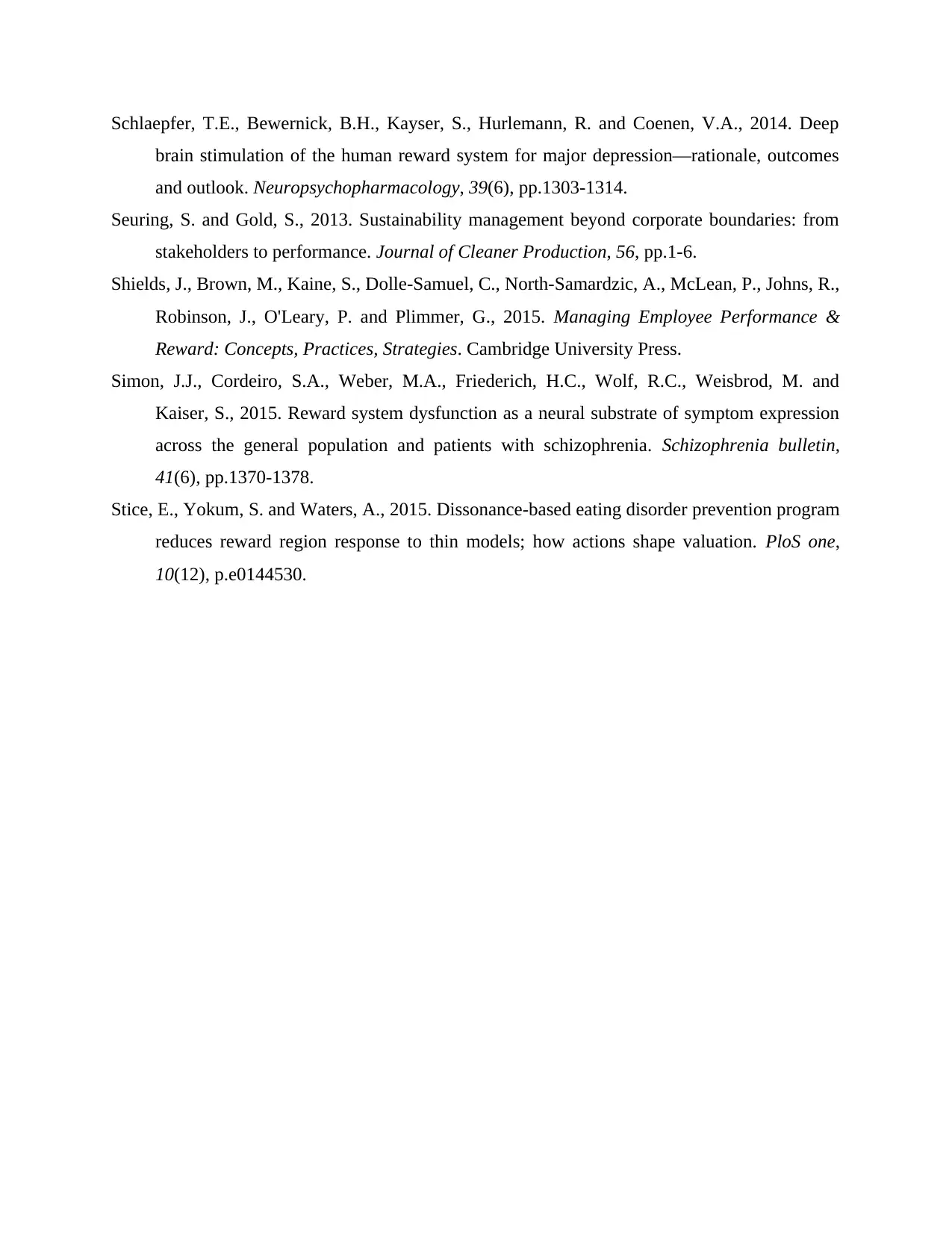
Schlaepfer, T.E., Bewernick, B.H., Kayser, S., Hurlemann, R. and Coenen, V.A., 2014. Deep
brain stimulation of the human reward system for major depression—rationale, outcomes
and outlook. Neuropsychopharmacology, 39(6), pp.1303-1314.
Seuring, S. and Gold, S., 2013. Sustainability management beyond corporate boundaries: from
stakeholders to performance. Journal of Cleaner Production, 56, pp.1-6.
Shields, J., Brown, M., Kaine, S., Dolle-Samuel, C., North-Samardzic, A., McLean, P., Johns, R.,
Robinson, J., O'Leary, P. and Plimmer, G., 2015. Managing Employee Performance &
Reward: Concepts, Practices, Strategies. Cambridge University Press.
Simon, J.J., Cordeiro, S.A., Weber, M.A., Friederich, H.C., Wolf, R.C., Weisbrod, M. and
Kaiser, S., 2015. Reward system dysfunction as a neural substrate of symptom expression
across the general population and patients with schizophrenia. Schizophrenia bulletin,
41(6), pp.1370-1378.
Stice, E., Yokum, S. and Waters, A., 2015. Dissonance-based eating disorder prevention program
reduces reward region response to thin models; how actions shape valuation. PloS one,
10(12), p.e0144530.
brain stimulation of the human reward system for major depression—rationale, outcomes
and outlook. Neuropsychopharmacology, 39(6), pp.1303-1314.
Seuring, S. and Gold, S., 2013. Sustainability management beyond corporate boundaries: from
stakeholders to performance. Journal of Cleaner Production, 56, pp.1-6.
Shields, J., Brown, M., Kaine, S., Dolle-Samuel, C., North-Samardzic, A., McLean, P., Johns, R.,
Robinson, J., O'Leary, P. and Plimmer, G., 2015. Managing Employee Performance &
Reward: Concepts, Practices, Strategies. Cambridge University Press.
Simon, J.J., Cordeiro, S.A., Weber, M.A., Friederich, H.C., Wolf, R.C., Weisbrod, M. and
Kaiser, S., 2015. Reward system dysfunction as a neural substrate of symptom expression
across the general population and patients with schizophrenia. Schizophrenia bulletin,
41(6), pp.1370-1378.
Stice, E., Yokum, S. and Waters, A., 2015. Dissonance-based eating disorder prevention program
reduces reward region response to thin models; how actions shape valuation. PloS one,
10(12), p.e0144530.
1 out of 16
Related Documents
Your All-in-One AI-Powered Toolkit for Academic Success.
+13062052269
info@desklib.com
Available 24*7 on WhatsApp / Email
![[object Object]](/_next/static/media/star-bottom.7253800d.svg)
Unlock your academic potential
© 2024 | Zucol Services PVT LTD | All rights reserved.




